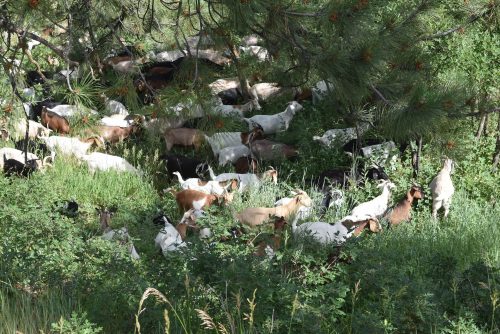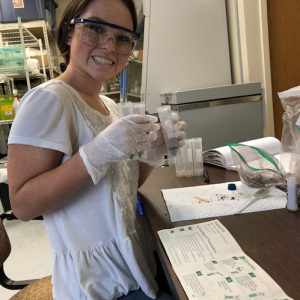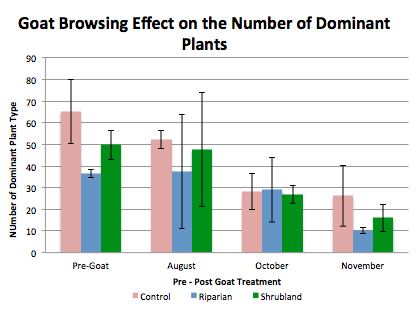Wildfires are an annual occurrence in the West – but what can kids do about it? Students south of Denver at Rock Canyon High School in Highlands Ranch, Colorado, decided to think outside the box when it came to conducting their own research and applying science to help the community they live in.
With the help of their teacher Jenny Sickle, an AP Biology and Environmental Science teacher, they applied for a GreenWorks! grant from Project Learning Tree to analyze the environmental impacts of goat browsing as a form of wildfire mitigation.


The Goats are Baaaaack

Every summer, the local fire department trucks in goats to browse the vegetation growing throughout several neighborhoods. Now, at the department’s request, local grade 10-12 students are conducting a long-term scientific field study to research the effectiveness of this fire mitigation method, as well as the environmental impacts on plant biodiversity and soil health.
Rock Canyon students partnered with Einar Jensen of South Metro Fire Rescue, and the Estates at Buffalo Ridge Homeowners Association, in what they called the “Ready, Set, Goat!” project in the Castle Pines community. The fire department had the goats but needed data to assess their effectiveness. Enter our student citizen-scientists.
The students set up the project as a scientific experiment: “We hypothesized that goat browsing would be an effective form of wildfire mitigation, as it would limit vegetative growth by six feet and have positive environmental impacts,” the students relayed via their teacher, Jenny Sickle. Loren Rylander and Delaney Yehle, both juniors at the time, took the research one step further by developing a partnership between their school’s Biotechnology and AP Environmental Science classes.
Rounding Up Data
Students collected data along three separate transects in the Buffalo Ridge neighborhood, where measurements were collected both pre and post-goat-treatment over a span of six months. A total of 300 goats browsed along the two experimental transects, while the control transect received no goat-treatment. The sample collections involved extracting soil and recording plant measurements.
The students discovered that goat browsing was an effective wildfire mitigation tool—at least in the short term—as vegetative density decreased between 49 and 66 percent.
To assess environmental impacts, students measured soil health and vegetative biodiversity, including: soil organic carbon, pH, and the nitrogen, phosphorus, and potassium levels within the soil. While goat browsing was found to be effective over the six months studied, the students recognized that longer-term investigation is still needed. An important part of the project involved communicating the results, especially in their approach to organizing and displaying the data to different audiences. The project went on to win multiple awards at regional and state science fairs, and students talked to the media, community groups, local firefighters, and others about their results.

Laying the Groundwork
Not everyone has goats to study, of course, but the students shared several ideas that can be replicated. “Community involvement and support can be crucial for citizen science projects,” they wrote. Local resources are also crucial partners. For our students, collaborating with the Colorado State Forestry Department was critical, and Colorado State University soil scientist, professor Jim Ippolito, was an important resource and ally. Finally, “getting a long-term commitment from a team of volunteers is very useful. We found offering volunteer service hours, which are a graduation requirement at our school, encouraged this commitment.”
Each summer for the past three years, Rock Canyon students have been collecting data about plant biodiversity, vegetation characteristics, and soil health in Castle Pines.

This year, three new students will continue the research project by analyzing the data for longer-term impacts of goat browsing on wildfire mitigation. The team plans to complete this project as a five-year study and will share their results with other communities who are considering this method of wildfire mitigation.
Learn more about this project from the students’ blog.



